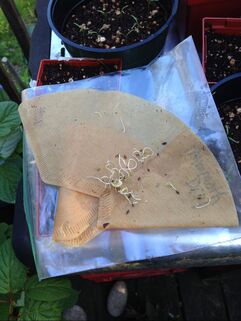 My first experience with soaking seeds was probably with something large, like sugar snap pea seeds. My second experience was probably with something like white beans, which hate to be soaked and often respond by rotting if you are not super careful. At the time, I had no idea there was a process called “priming.” Some kinds of seeds (grass seed) may be sold “primed.” This mean’s it’s been presoaked and then dried again so that it will sprout more quickly when planted in a lawn. The downside is that primed seeds do not have the shelf life of unprimed seeds. It’s a “use it or lose it” situation. When you create and care for client veggie gardens as I do, it can be a bit of a balancing act. Some veggies need to stay moist to germinate, a challenge if nobody is at the house to water. If I’m also taking care of some landscape needs at the house down the road, it’s no big deal to check in on the carrots-to-be, for example. When I'm not able to be at the garden often, pre-sprouting helps. Priming and warming those pepper and tomato seeds can also speed up plant development by a few days. When plants are tricky to start from seed in the garden, starting seeds indoors allows me to control and optimize the growing conditions. This year, I have a client who wants dill in her doorstep herb container garden. Dill, you may know, is not a fan of being transplanted. It often bolts not long after transplanting, so I can see some succession plantings on the horizon. I decided to experiment with priming dill seeds so I could plant some seedlings in the doorstep pot, while starting some seeds that will come out from backstage when the first batch starts to get tired out and go to seed. Here’s what I did:
Not all seeds respond equally well to being soaked. Arugula seeds, for example, get a mucilaginous coating and clump together. White beans are easy to over-soak, resulting in rotten beans. Some seeds need heat to germinate well (tomatoes, eggplant, peppers); others refuse to germinate with too much heat (lettuce!). It helps to look up optimal germination temperatures for the seeds you're starting. As to heat: If it's not a seed that will sprout easily at room temperature, then a heat source is needed. Very few refrigerator tops are as hot as those our grandparents' appliances used to start seeds, but presoaked seeds in moist coffee filters tucked into plastic bags, wrapped in a towel, and placed against a heating pad will move pepper and tomato seeds along nicely, using less heat than would mats to heat numerous trays. Once the seeds start to show roots, they can be transplanted into cells, trays or pots. (Oh, by the way: Not all heating mats are well quality controlled, and I have a scorched wooden table top to prove it!) Does seed starting still seem too daunting? My advice is simple: Just. Do. It. Seed starting is thrilling. I like to bring a sense of adventure to working with seeds — trying something I have never even tasted, experimenting with pushing seed sprouting to occur faster, or dipping into methods somebody else has tried and reported on. Early on, when I too was daunted, I finally asked myself, "Why do I want perfection in starting seeds? A $2.75 packet of seeds may not sprout? Can't I live with that?" (Oh, and the seeds did sprout, by the way...) If you are curious to know more about seed priming as it is done professionally, this article gives a glimpse of how it might work if you had thousands of seeds to do and not just a few out of a packet: https://www.thoughtco.com/seed-priming-speeding-up-the-germination-process-419193
0 Comments
 Photo by Alek Kalinowski on Unsplash Photo by Alek Kalinowski on Unsplash Intrusive sounds on a landscape design project at times threaten to get in the way of the reason many of us make gardens, throwing cold water on the hope that they can comfort, heal, and create tranquility. Sometimes the sound in the garden is not one of birds, wind in the trees or spring peepers. Instead, a walk through the green space is accompanied by the cacophony of downshifting trucks, fast traveling vehicles, sirens or train horns. What to do? First, be clear what plans can and cannot do. In the best of circumstances, often it is very difficult to mitigate sound appreciably using vegetation, unless you have a lot of space and a lot of plants and money. Visual screening is psychologically soothing, but some sounds are too intrusive to be impacted much by a few evergreens. If looking at the inside to get rid of sound on the outside, It is also hard to retrofit sound proofing into e.g.the walls of a bedroom. The area where the sound is a problem may be a key to the strategy to try to offset it. Sound is amplified when it bounces off buildings and hard surfaces, so that sound can be actually louder right beside the hard surface (house?) than say 20 feet closer to the sound/away from the house due to this characteristic. Vines on a building or wall help reduce reflection and muffle the sound a bit. Don't count on a row or two of shrubs or evergreens, however. Because sound travels like water, it can and will find a way through anything that is not super tight, or just go over the top of a fence. The source of the sound, pitch (high or low) and elevation of the sound are useful to observe. (second floor of the house being demo'd? street level?) In the realm of relatively simple solutions, they may go beyond the garden and into the house. Moving the bedroom or sitting room to the opposite side of the house (whatever is key to where the owner spends time( location may turn out to be the least expensive and fastest way to start enjoying life again, since the lived- in areas may receive less noise. After doing so, changes to the landscaping to make wonderful view from that newly repurposed room wonderful could make use of the house itself as a sound barrier. There are also indoor and outdoor water features, and that might be a distracting and pleasant counter to the exterior ruckus. Keeping the rooms as they are and trying a planted screening between the sound and the observer will have other positive psychological effects (people who have a tree view out the window in hospitals got well faster in one study). But out of sight does not mean that sound will not travel. Think of sound as moving similarly to water. It will find a way through most anything! One other factor in sound mitigation is that higher-pitched sounds occur to the human ear as louder (more intrusive) than lower pitched sounds. It can be useful to listen to annoying sounds yourself to observe which sounds are most bothersome, considering whether pitch is a factor. Lower pitched sounds travel farther but are less intrusive, it is said. (This may be in the ear of the beholder, especially if a medical condition impacts how the sound is heard.) In the example of train horn noise, I discovered that the Metro North train horns are required by regulation to blast between 96 and 110 dBa. Much discussion focused on whether the horns were "too loud," and the railroad countered that they were "within legal limits". None of this helped the family who recoiled in intense pain when a train horn was blasted not far from their home. After intensive research, I learned that within the past few years, the railroad had actually changed the tones involved in the horn blast (each railroad's horns have a distinctive set of notes), adding one higher pitched note. It was when the pitch got higher that residents who had lived along the railway started complaining about the noise, thinking it was louder. People do hear higher pitched sounds as louder than equally loud lower pitched sounds. If sound mitigation is a prominent consideration in a landscape, remember that a lot of money can be poured into a poorly understood problem, and sound is frequently incompletely understood by designers. There are companies that will first analyze the characteristics of the sound, and then recommend an array of (their) solutions that will best address them. Few designers are accustomed to using them, but those who do are likely to find the shortest path to a satisfactory solution to an intransigent, intrusive problem. Not doing so might take a longer, more meandering route through a series of not-quite-satisfactory attempted solutions. In the end, starting the process with the mist intransigent problem and consulting with a sound engineer or specialist may save time and money in the long run and point the way to a technical solution that can be gracefully integrated into the rest of the landscape design. |
Categories
All
Our Blog
The Root of the Matter is a blog created by Bespoke Gardening owner Christine Reid to share observations and in-depth insights from a seasoned professional gardener. Edible gardening, perennial gardens, and shrubs and trees — as well as the environments in which they live and the ways we care for them — are all areas of interest. Archives |
Copyright © 2022 Bespoke Gardening, LLC. All Rights Reserved


 RSS Feed
RSS Feed